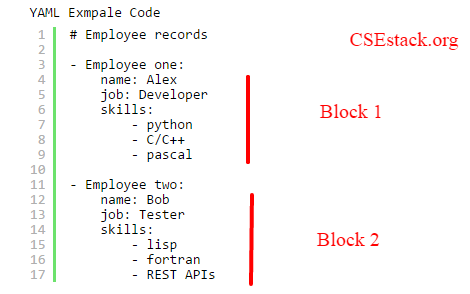Advantages and Disadvantages of YAML over XML and JSON
If you are new to YAML, let’s see what is YAML. This will make easy to understand all the disadvantages and advantages of YAML over XML and JSON.
What is YAML?
YAML is a data serialization language just like JSON and XML. It uses indentation format to define the structure.
In the given example, you can see the indentation used to define the block in YAML code.

It has an indentation format just like Python. If you have any experience of working with Python, you might be aware of indentation. They use a consistent number of spaces to define the block of the structure.
There are so many alternatives to YML as serialization language. Some are XML and JSON. These are the most popular and widely used.
There is also a CSV file format. You may have seen this file standard while importing and exporting contacts to your smartphone. [Related Read: How to read CSV file in Python Program?]
Use of YAML
What are the uses of YAML and other Data Serialization Language?
- Importing and exporting data to and from the server.
- Configuring application with a single file. These files specify the configuration parameter and its corresponding values.
- Transferring data between two different components of the application.
- Intermediate data storing.
There are certain advantages of using YAML over XML and JSON. And this is the reason, nowadays, many programmers are using YAML over XML and JSON.
Advantages of YAML
- In YAML, there is no extra delimiter is used. So it is the lightweight than XML and JSON.
- YAML, not using delimiter also makes the reading light and simple. (I am not sure if you agree with this point. Because many geeks find it easier to read the data in content delimiter or tags separate those.)
- YAML makes the data understanding easy. So it is useful in case of configuration.
- YAML has a wide variety of uses and popular for. It can be used for configuration, then from transferring data to storing intermediate data.
- YAML is the superset of JSON. You heard it right. Whatever valid JSON code you have, it will be parsed by YAML compiler. So choosing YAML over JSON for your project you have one advantage. You can parse both JSON and YAML code with the single parser (YAML parser).
Why YAML is not so popular?
As compare to other JSON, XML, why are more programmers not using YAML?
YAML has not popular as expected. Each serialization standard has their own comfortability with other programming languages.
Read the difference between YAML, JSON, and XML.
There is some obvious reason. Let’s talk about it.
Disadvantages of YAML
- There are so many applications that are already build using XML or JSON, so it hard for a developer to replace this with YAML.
For instance, I am developing a plugin for the existing project which uses XML. I would like to use XML in the plugin. So it will be easy for me to merge plugin with an existing project.
- Talking about the popularity, XML has much more matured ecosystem than YAML.
- JSON [JavaScript Object Notation] exists since early 2000s and it is highly adopted by many as compare to YAML. So it is easier to find the support for JSON over YAML.
- There are extra precautions while writing YAML code. Even if you mismatch single space while indentation, your code can stop working.
- There are many ways to represent data in YAML and make data hierarchy. So it is complex for processing. So JSON and XML have better performance than YAML.
Final Words
YAML is a data serialization standard which uses indentation. So there are some advantages of YAML that comes with it. There are also some disadvantages of YAML. Some developers find it difficult to use for its complex indentation formatting.
If you are developing a new project from scratch, you can give a thought for choosing any of the serialization languages. It will priorly depend on your prior development use cases and your comfortability.
I am complete Python Nut, love Linux and vim as an editor. I hold a Master of Computer Science from NIT Trichy. I dabble in C/C++, Java too. I keep sharing my coding knowledge and my own experience on <b>CSEstack.org</b> portal.


I’m not sure yaml is so lightweight comparing to json, did you think of all those required whitespaces (+ the dashes and others yaml special chars) ?
YAML is slightly smaller than the JSON file because of extra double quotes and semicolon (even after considering white spaces and dashes in YAML). Moreover, it is possible to make YAML parser that runs quicker than JSON.
It is a very slight performance difference. So it is difficult to differentiate two. Most of the time, choosing one is purely depends on what you feel comfortable.
“it is possible to make YAML parser that runs quicker than JSON”
“YAML is the superset of JSON. You heard it right. Whatever valid JSON code you have, it will be parsed by YAML compiler. So choosing YAML over JSON for your project you have one advantage. You can parse both JSON and YAML code with the single parser (YAML parser)”
Aniruddha, I hove you can see why it is not possible for both of these statements to be correct.
JaSON, I may have framed it wrong or you may not be getting what I mean. JSON or YAML codes are input to the parser. Along with the complexity of the parser, the speed of the parsing even depends on the type of input we are passing. As YAML is lightweight (explained in the blog above), passing YAML code as an input to the parser makes parsing quicker than parsing JSON code with the same parser. Hope it clears.
YAML is ok, but the way how it is butchered in helm templates is just awful.